

The Original New Music Community

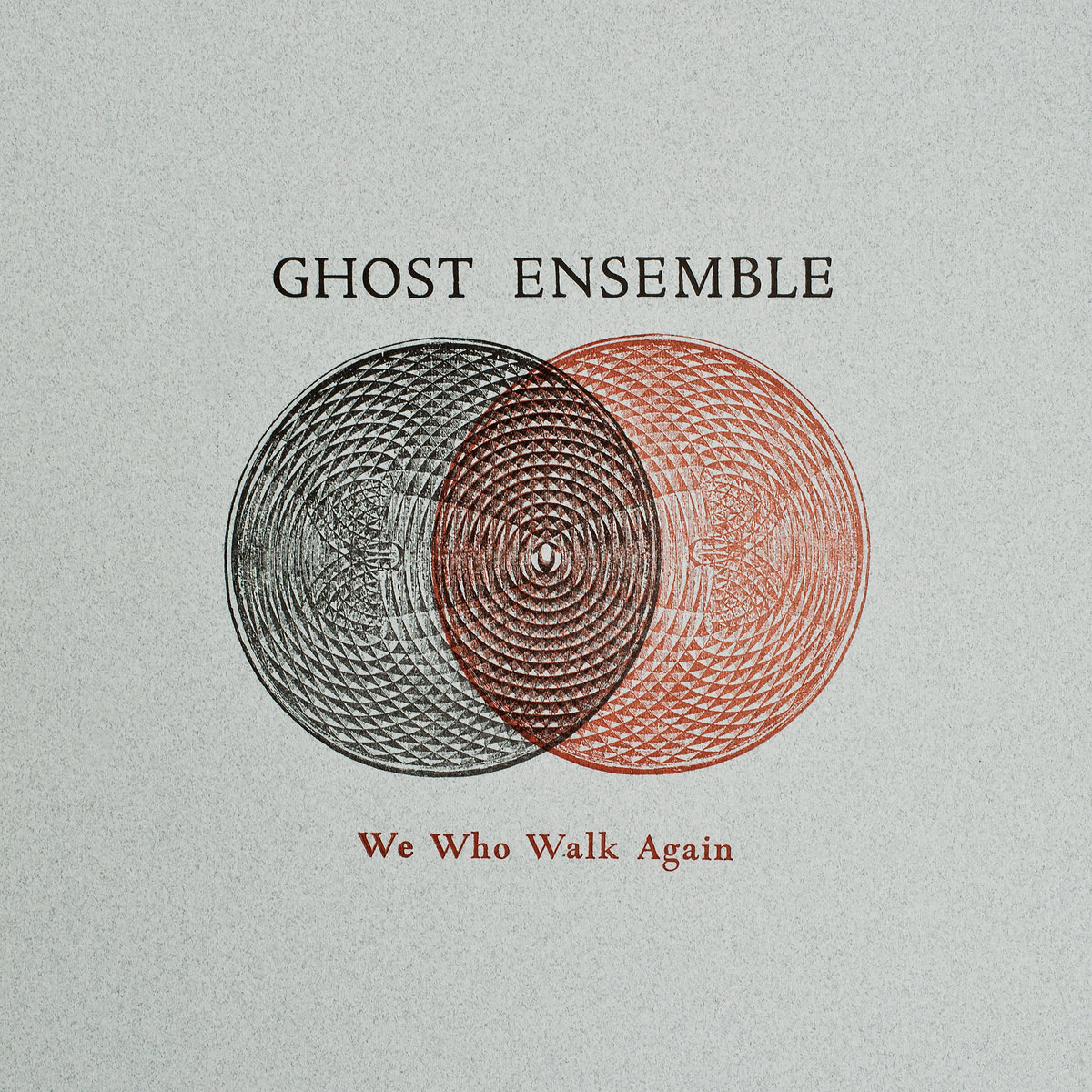
We Who Walk Again
Ghost Ensemble
Indexical LP/Download
Since 2012, New York’s Ghost Ensemble has pursued a deep listening ethos that incorporates a range of repertoire, both pieces by ensemble members and works by composers such as David Bird, Kyle Gann, Giacinto Scelsi, and Gerard Grisey. Any ensemble in the US that references “deep listening” invariably is also interested in Deep Listening, the piece that evolved into a discipline and subsequent body of musical and theoretical work from sound artist Pauline Oliveros.
Since its inception Ghost Ensemble has been associated with Oliveros’ work, both her compositions and sound practices. It is fitting that We Who Walk Again, their debut recording, features the first studio recording of the Oliveros piece “Angels and Demons.” A text score from 1980, its primary guideline is as follows: “any sound that has been heard inwardly first may be made.” Players may take on the role of “Angels,” the meditation’s “guardian spirits,” or Demons, “individual spirits of creative genius;” they may also switch back and forth between roles. Here the piece manifests itself in an initial testing out period of slow individual tones that is gradually varied by means of timbre, density, and use of dissonance. Starting in the Feldman realm of spare pianissimo fragments, a long range crescendo shapes the piece. It is enabled by successively more penetrating held pitches, extended techniques, syncopated percussion, and an eventual blossoming of rangy melodic gestures. A belated denouement supplies a few furtive valedictions, but no dramatic close is supplied (nor does one seem necessary).
The group’s oboist Sky Macklay is also a composer on the rise, with a number of high profile performances and commissions to her credit. Macklay’s 60 Degree Mirrors revels in extended techniques available to winds. Her command of multiphonics and microtones on the oboe is prodigious and she gives flutist Martha Cargo a detailed part as well. The piece also has spectral roots, with shimmering overtones, particularly “crunchy” upper partials, demonstrating an edgier side of the “deep listening” continuum. 60 Degree Mirrors is not just technically sophisticated; it has considerable dramatic heft and proves to be a thrilling listen.
Ghost Ensemble founder, accordionist and composer Ben Richter, provides the recording’s other piece, Wind People. More than double the length of the Macklay and Oliveros performances, it affords the group the opportunity to stretch out and engage in the shaping of a larger arc. Long glissandos played by bassist James Ilgenfritz provide a particularly resonant touchstone, and similar sliding tones from violist Hannah Levinson and cellist Maria Hadge underscore its structural character. Meanwhile, the winds explore all manner of overtones, sometimes punctuating the proceedings with held pitches appearing in contrast to the yawning slides, at others engaging in pitch bends of their own. Percussionists Chris Nappi and Damon Loren Baker provide under-girding drums, subtle yet insistent. Richter and harpist Lucia Helen Stavros sometimes pepper the texture with melodic gestures, but more often are the harmonic “middle” that sustains the fabric of the piece. Over time, sustain becomes a powerful force traversing all instruments and registers, and sumptuous overtone chords saturate the work. A coda provides a long diminuendo in which overtones fade into thrumming drums, drones, and string glissandos. Wind Music is a well-crafted and eloquent work.
Of Wind Music, Richter says that he sought to “draw a sense of peace and comfort from our smallness, transience, and fragility in the face of an overwhelming immensity, the music mirroring the constant ebb and flow visible when zooming in or out to quantum or geological time.”
Amid today’s tumult, drawing peace and comfort from deep listening is a worthy goal, one that Ghost Ensemble appears poised to attain often.
Da Capo Chamber Players Perform a Potpourri of American Works
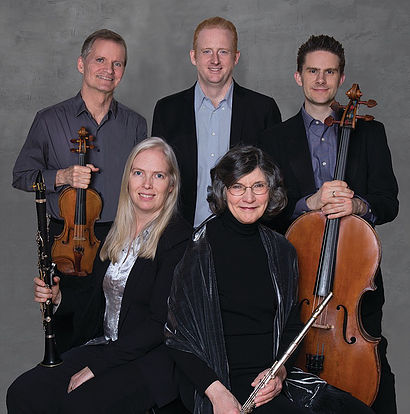
Da Capo Chamber Players
Merkin Concert Hall
June 4, 2018
NEW YORK – Themed programs and portrait concerts are all the rage these days. As such, it is refreshing when an ensemble goes eclectic, presenting a diverse array of music. Such was the case on Monday, June 4th, when Da Capo Chamber Players performed eight pieces by living American composers who write in a plethora of styles. Consisting of violinist Curtis Macomber, cellist Chris Gross, flutist Patricia Spencer, pianist Steven Beck and joined by guest artists soprano Lucy Shelton, clarinetists Marianne Glythfeldt and Carlos Cordeiro, and percussionist Michael Lipsey, the musicians are a formidable cadre of some of New York’s best new music performers. This was handily demonstrated in all of the works on offer at Merkin — how often can you depend on that level of consistency?
Few groups perform the rhythmic patternings of minimalism more assuredly than the Da Capo Players. Here they clearly delineated the differences between various types of ostinatos. Sweet air (1999) by David Lang juxtaposed its repetitions with distressed dissonances, In the sole premiere on the program, Dylan Mattingly’s Ecstasy #3 (2018) presented passages filled with an alt-folk-inflected melody. An arrangement by Robert Moran of Philip Glass’s Modern Love Waltz (1980) may have explored repetition in the most straightforward way of the pieces here, but its fluid playfulness made it a fetching addition to the proceedings.
The modernist wing of composition was represented too. Elliott Carter’s Canon for Four (1984) received an incisive rendition, with the contrapuntal details of the work vividly underscored. Tanoa León’s One Mo’ Time (2016) mixed a varied palette of chromaticism with inflections of gospel and jazz. She is one of the best at allowing these two traditions to coexist in her music in organic fashion. Christopher Cerrone supplied one of the evening’s most imaginative works. Hoyt=Schermerhorn for keyboard mixed a gradual build-up of soft textures that was somewhat indebted to the works of Feldman but through quicker changes of harmony. Over time, effects such as reverb and treble register loops brought the piece from its eighties origins into the twenty-first century. Amalgam (2015) by Taylor Brook, was the concert’s most experimental piece, with the players (and soprano Lucy Shelton) moving from disparate roles to unison playing, then heterophonic treatment of the piece’s melody. Amalgam is a fascinating composition that certainly proved to be a successful experiment for Da Capo.
The concert’s standout was Romancero (1983), for soprano and ensemble, settings of four medieval poems thought to be from the Sephardic Jewish tradition by Mario Davidovsky. Shelton was as expressive as ever and well-matched for the angular challenges posed by Romancero’s post-tonal pitch vocabulary. Her voice ranged from delicately floating pianissimo passages to forceful forte declamations. The instrumental parts are quite demanding as well, reminiscent of the complexly articulate language of Davidovsky’s electroacoustic Synchronisms. Shelton is a frequent collaborator with Da Capo (see a recent video of their rendition of Arnold Schoenberg’s Pierrot Lunaire below), and their association showed in the intricate interplay between voice and instruments: a gem of a performance.
As if to remind us of the celebratory catholicity of taste that bound together the disparate strands of this program, its finale was the brief, yet brilliantly multi-faceted, Encore (1991) by Bruce Adolphe. Composed to celebrate the Da Capo Players’ twentieth anniversary, it has remained a staple of their repertoire. It is hard to believe that the group has now been going for 48 years. Based on the vigor with which they performed at Merkin Hall, the sky’s the limit for their upcoming golden anniversary season.
[youtube https://www.youtube.com/watch?v=Vw-OItKIZMc&w=560&h=315]
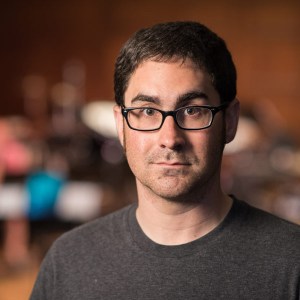
All of us at Sequenza 21 are saddened to learn of the passing of Matt Marks. A musical polymath, he was a composer, new music advocate, provocative Twitter presence, co-founder and key organizer of New Music Gathering, and a versatile performer, both a vocalist-actor in various projects and a founding member of the ensemble Alarm Will Sound, in which he played French horn and for which he did imaginative arrangements.
I met Marks on several occasions, but will allow his close friends and family to share reminiscences of a more personal nature. Among all those who knew and encountered him, either as a social media presence or “IRL,” his intelligence, sense of humor, persistent advocacy for gender equality in concert music and other worthy causes, and formidable talent will be sorely missed. Condolences to the many people whose lives he touched.
Read and Listen Further: Matt Marks
Matt Marks on Twitter.
The Matt Marks Music Page (personal website).
Matt Marks at New Music USA.
A 2017 review in the New York Times of Marks’s opera Mata Hari.
And a scene from the opera:
Mata Hari from PROTOTYPE Festival on Vimeo.
Steve Smith, writing in 2010 in the NY Times, profiled A Little Death, Vol. 1, a performance piece and recording with soprano Mellissa Hughes for New Amsterdam. It served as an introduction to Marks’s music for many.
Arrangement of “Revolution Number 9” for Alarm Will Sound:
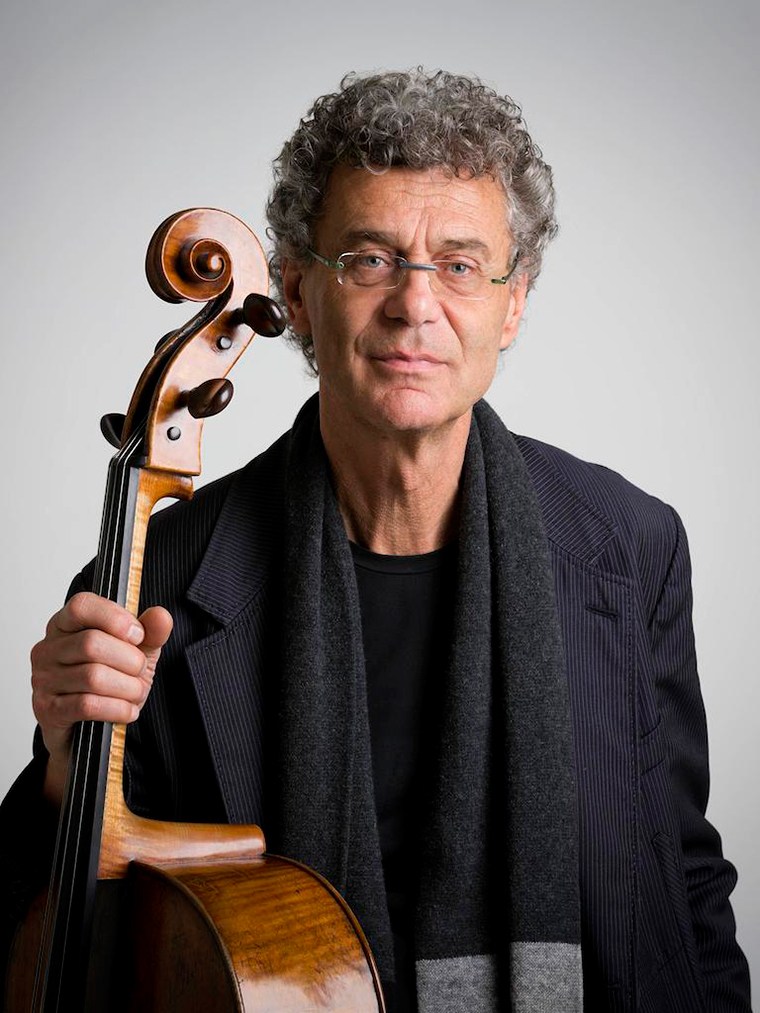
(Photo credit: Ismael Lorenzo)
In the presence of Thomas Demenga, there’s no such thing as a solo concert, for one considers not only the unrepeatable coincidence of performer and instrument but also the composers whose creations bond them. Such fullness of vision was already evident in 1987, when the Swiss cellist began pairing J. S. Bach’s unaccompanied cello suites with contemporary counterparts in a flight of albums for ECM New Series. The first of these viewed the Suite No. 4 through a lens crafted of Heinz Holliger’s chamber pieces, thus setting precedent for a compelling traversal of deciduous and coniferous music. Two composers engaged along the way in the studio—Elliott Carter and Bernd Alois Zimmermann—tangled roots on stage with Bach’s first and third suites for an April 23, 2018 recital at Weill Recital Hall in New York City.
Demenga’s approach to the suites was by turns monochromatic and fiercely colorful. He elicited both suites without a score, Bach’s eternal relevance as ingrained as the striations of the older cello on which he channeled it. He was careful to sand off anticipated peaks and finesse the deeper digs, lest we forget the ways in which Bach’s suites dialogue with themselves, all the while maintaining an underlying spirit of the dance (especially in No. 3’s foot-stomping gigue). In addition to its robust fluidity, his bow was constantly toeing, and at times joyfully crossing, the sul tasto threshold. This allowed natural harmonics and incidental whispers of the strings to bleed through as a veritable sonic fingerprint of the performance. Most impressive was his handling of each allemande, by which he stretched an indestructible suspension bridge from préludeto courante.
Between the pillars of Bach stood the statue of Zimmermann, whose 1960 Sonata for Solo Cello (originally paired with the Suite No. 2 in Demenga’s 1996 album for ECM) was a highlight of the evening—not only for its technical difficulties but also for its sheer musicality. Said difficulties were rendered wondrously in Demenga’s handling. The trembling with which the five-movement sonata opened revealed one mosaic of microtonal transference after another, while deft alternations of pizzicato and arco statements underscored a contrapuntal whimsy. Zimmermann’s score further revealed the same multifaceted understanding of notecraft that Demenga drew out in his Bach interpretations. Carter’s Figment for Solo Cello (1994), a piece written for its performer, likewise opened the concert with a strangely cohesive mélange of lyricism and punctuation. Every gesture was the start of a potential journey. As with much of Carter’s late output, a feeling of inner momentum abounded. Like the arpeggiated etude of Jean-Louis Duport with which Demenga encored, it was a testament to the asymptotic nature of artistic growth.
Such proximities bolded the forward-looking reach of Bach’s music as well as the foundational seeds over which Carter and Zimmermann poured their grateful waters. This reciprocation lent a sense of interconnectedness, of downright genetic heritage, to the sounds, proving that it takes more than a bow and fine muscle memory to extract the beauty therein, but a heart animating it all with genuine love by which each note is released as a messenger into the next continent of time.
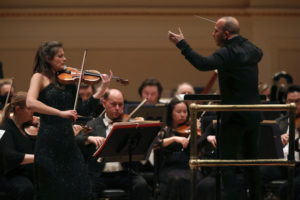
Photo: Steve J. Sherman
New York Premiere of Van Der Aa Violin Concerto
The Philadelphia Orchestra
Yannick Nézet-Séguin, Music Director and Conductor
Janine Jansen, Violin
March 13, 2018
Carnegie Hall
Published on Sequenza21.com
By Christian Carey
NEW YORK – Dutch composer Michel Van der Aa (b. 1970) is best known for his imaginative and formidably-constructed multimedia works that incorporate both film and electronics. Notable among these are the operas Blank Out (2016) and Sunken Garden (2012), as well as a music theater work based on Portuguese writer Fernando Pessoa’s The Book of Disquiet (2008). Even pieces for acoustic ensembles, such as the clarinet chamber concerto Hysteresis (2013), have frequently incorporated electronics as part of their makeup. Thus, when Van der Aa composed his Violin Concerto (2014) for soloist Janine Jansen and the Royal Concertgebouw Orchestra, the absence of electronics was significant. (Interestingly, after the success of the concerto, his follow up piece for orchestra, Reversal (2016), also abstains from the electronic domain). However, even in the analog realm, Van der Aa incorporates a sound world that acknowledges his interest in decidedly non-classical elements.
The score indicates that the solo violin part should be played with the vibrato, portamento, and usual techniques common to the instrument in contemporary concertos. The accompanying strings however, are asked to refrain from using vibrato in sustained passages, creating a kind of sine tone effect. Various styles are incorporated in the solo part, from bluegrass fiddling to more angular contemporary passages. Other aspects of the orchestration hearken to pop music terrain: near the end of the first movement, for instance, a climax approaches house music in its boisterous brass and percussion.
On March 13th, joined by Jansen, the Philadelphia Orchestra, conducted by Yannick Nézet-Séguin, delivered an energetic and assured performance of the concerto at Carnegie Hall. The violinist played with the supreme confidence of a soloist who has endeavored to make a work entirely her own. With its variety of solo demeanors, both shaded and nuanced and explosive and mercurial, Van Der Aa’s Violin Concerto seems the ideal vehicle for Jansen’s multi-faceted artistry. The Philadelphians matched her playing with equal confidence, with strings sensitively taking up the “sine tone” accompaniment of the sostenuto passages and winds, brass, and percussion gamely taking on roles in the electronica mimicry of wide swaths of the piece. Interpretively speaking, Jansen and Nézet-Séguin were on the same page throughout. In a dramatic conclusion to the piece, the violinist played her last gesture nose to nose with the conductor, eliciting surprised exhalation and then sustained applause from the audience.
Sergei Rachmaninov’s Second Symphony is one of my favorite of the composer’s works and I have seen a number of performances of it in concert. While I might quibble here or there with Nézet-Séguin’s tempo choices, the conductor’s tendency to press ahead during the potentially “schmaltzy” moments of the piece rendered it free of several layers of sentimental “varnish:” still emotive yet utterly fresh-sounding. The Philadelphia Orchestra’s strings are justly renowned and were exemplary here, but the winds, brass, and percussion each contributed in both spotlight and ensemble moments as well. Thus, it was a touching exchange onstage when the conductor insisted on walking out to each of them in turn, bestowing embraces and well-earned praise.
Jansen and the Royal Concertgebouw Orchestra, conducted by Vladimir Jurowski, have recorded Van Der Aa’s Violin Concerto for Disquiet Media. It is paired with the aforementioned Hysteresis, performed by Amsterdam Sinfonietta, directed by Candida Thompson, with Kari Krikku as soloist. The performances are detailed and evocative, giving an excellent sense of the composer’s approach to ensemble works. One hopes that both the recent high-profile performances of the Violin Concerto and this persuasive recording prove inviting to other soloists and ensembles: Van der Aa’s work is worthy of wider currency.

Tuesday: JACK/SO Tonight at Zankel
Performances at Zankel Hall on March 6 at 7 PM (note the early start time) will feature two of contemporary classical music’s estimable chamber ensembles. JACK Quartet and SO Percussion team up in a program that includes a string quartet premiere by Philip Glass, a pitched percussion work by Donnacha Dennehy, and a piece for the combined forces and prepared disklaviers by Dan Trueman. (Tickets here).
******
Open Source Music Festival 2017
Recently Open Source Music Festival was kind enough to send us some videos of JACK and pianist Joel Fan performing as part of the 2017 Festival. We’re still decoding the JACK offerings and will post them another day. But below, Fan plays two pieces by Augusta Thomas and Bernard Rands. Collectively titled ‘Two Thoughts about the Piano,’ they demonstrate the pianist’s virtuosity, with trills, repeated notes and angular gestures abounding to explore the entire compass of the instrument. Follow the YouTube link to hear the rest of the performances.
The Music of Sheila Silver: A Celebration
Merkin Concert Hall
February 8, 2018
By Christian Carey
Published on Sequenza 21
NEW YORK – Composer Sheila Silver has taught at Stony Brook University since 1979. On February 8th at Merkin Concert Hall, an all-Silver program celebrated her tenure at the university. In addition to colleagues and students past and present, the hall was filled with area musicians – including multiple generations of composers – who were most enthusiastic in their reception of Silver and the estimable renditions of her work.
Even when composing instrumental music, Silver often bases her work on literature and describes it in terms of its narrative quality. The earliest piece on the program, To the Spirit Unconquered (1992), played by Trio de Novo – Brian Bak, violin, Phuc Phan Do, cello, and Hsin-Chiao Liao, piano – is inspired by the writings of Primo Levi, a survivor of the Holocaust who was imprisoned in Auschwitz. One of Silver’s most dramatic compositions, in places it is rife with dissonance and juxtaposes violent angularity with uneasy passages of calm. In the video below, Silver mentions trying to imbue it both with the searing quality of Levi’s struggle and, at its conclusion, some sense of hope based on his indomitability in the midst of horrendous experiences. Trio de Novo are a talented group who performed with detailed intensity and imparted the final movement, marked “stately,” with exceptional poise.
Soprano Risa Renae Harman and pianist Timothy Long performed an aria from the opera The Wooden Sword (2010), in which Harman displayed impressive high notes to spare. Her acting skills were on display – comedically sassy – in “Thursday,” one of the songs from Beauty Intolerable (2013), Silver’s cycle of Edna St. Vincent Millay settings. Soprano Lucy Fitz Gibbon, joined by pianist Ryan McCullough, presented another, more serious, Millay song, “What My Lips Have Kissed.” With Bak providing additional atmosphere, they also performed an aria from Silver’s current work-in-progress, the opera A Thousand Splendid Suns. Gibbon sang with considerable flexibility and purity of tone, at one point exuberantly spinning around while effortlessly holding a high note. Currently part of the group workshopping the opera, she seems perfectly cast. The songs and arias displayed a sumptuousness that served as a fine contrast to the denser language of the piano trio.
Dawn Upshaw was slated to perform with pianist (and longtime Stony Brook faculty member) Gilbert Kalish. Sadly, Upshaw had bronchitis and couldn’t sing on the concert. Gibbon valiantly stepped in, learning Silver’s On Loving, Three Songs in Memory of Diane Kalish (2015) in just two days. Her performance on the concert was supremely confident, betraying none of the last minute nature of the switch. Indeed, the three songs – settings of Shakespeare, St. Vincent Millay, and Khalil Gibran, were among the most stirring of Silver’s works on the program, displaying an autumnal lyricism and wistful poignancy. Kalish, a renowned accompanist, played with characteristic grace.
The second half of the concert showed still two more aspects of Silver’s work: a short film score and a more overtly political chamber piece. The first, Subway Sunset (1999), is a collaboration with her husband, the filmmaker John Feldman. It intersperses scenes of busy commuters with a gradually encroaching sunset adorning the sky near the World Trade Center. Although filmed before 2001, the duo dedicated it to the victims of 9/11. Seeing the towers on film will always be haunting. The musical accompaniment, a duet played by bassoonist Gili Sharret and pianist Arielle Levioff, created a solemn stillness that left space to contemplate the various implications of what used to be a normal scene for twentieth century commuters.
The program concluded with Twilight’s Last Gleaming (2008), a work for two pianists and two percussionists that is a commentary on the post 9/11 state of affairs. Its three movements’ titles – War Approaching, Souls Ascending, Peace Pretending – give a broad outline for the work’s impetus. Twilight’s Last Gleaming requires stalwart performers and Kalish, joined by pianist Christina Dahl (also on Stony Brook’s faculty) and percussionists Lusha Anthony and Brian Smith, provided a committed and energetic account of this challenging and penetrating piece. The large percussion setup included a considerable assortment of gongs as well as various pitched instruments and drums. The percussionists engaged in a complex choreography between parts, at times catwalking around the gongs’ stands to arrive perfectly in time for their next entrance. In the piece’s final section, an extended musical deconstruction of “The Star-Spangled Banner” takes place with all of the musicians engaging in an increasingly fragmented presentation of the tune. The piece closes leaving the penultimate line “The Land of the Free…” cut off by a musical question mark: a powerful ending to an evening of eloquent music.

Quattro Mani
November 15, 2017
Weill Recital Hall
Works by Gosfield, Moravec, Machover, Lansky, and Ben-Amots
NEW YORK – Since 2013, pianists Susan Grace and Steven Beck have been performing together as the duo Quattro Mani. Their recent recital at Carnegie Hall’s Weill Recital Hall presented several New York premieres, including pieces by Annie Gosfield, Paul Moravec, Tod Machover, and Paul Lansky. Gosfield’s mix of dissonance with rollicking rhythms was winning in “Refracted Rhythms and Telepathic Static.” Lansky’s three Color Codas – “In the Red,” Purple Passion,” and “Out of the Blue” – indeed embodied multihued harmonies and sparking ostinatos. Moravec writes in an elegant, idiomatic style for the piano. His Quattro Mani contains a substantial amount of memorable material — dare one hope it is a sketch for a double concerto? The evening culminated in a scintillating performance of John Adams’ Hallelujah Junction, which was both fiery and superbly coordinated.
Quattro Mani’s latest CD recording for Bridge Records, Re-Structures, is an engaging outing. The title work, also heard at Weill Hall, is by Machover. Scored for piano and electronics, it juxtaposes frenetic acoustic virtuosity with correspondingly penetrating digital commentary. Lansky’s Out of the Blue, one of the Color Codas also on the New York program, is an attractive post-minimal exploration of small cells of material that gradually expand into boisterous passages in octaves and quick scalar runs.
The multi-movement work Cembal d’Amore, Book Two by Poul Ruders changes up the duo’s instrumentation: Beck plays harpsichord while Grace remains at the piano. Its corruscating textures, varying duplications and canons in a sequence of movements based in part on Baroque dance suites, revels in chromaticism and wry wit in equal measure. Yet another shift in approach is found in Életút Lebenslauf by György Kurtág. Basset horns, played by Andy Stevens and Sergei Vassiliev, accompany the pianists playing instruments tuned in microtones. Mysterious timbres bump elbows with thornily dissonant angularity in a piquant, unforgettable piece.
The CD’s closer is a bit more straightforward, but no less captivating. Tango for the Road by Ofer Ben-Amots is an eight-minute long exploration of traditional tango rhythms and gestures, with a few surprises and a left turn or two along the way. The piece gives Grace and Beck an ideal vehicle to showcase the supple phrasing and suavity they bring to bear whenever given a chance to swing.
Re-Structures is an adventurous exploration of many facets of 21st century piano music: highly recommended.
-Christian Carey
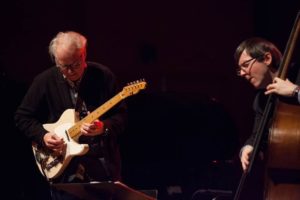
Photo: Claire Stefani
Bill Frisell and Thomas Morgan
The Jazz Standard
December 10, 2017
Sequenza 21
By Christian Carey
NEW YORK – Like the dearly departed duo of Jim Hall and Charlie Haden, guitarist Bill Frisell and bassist Thomas Morgan make a sound much greater than the sum of their parts. This is not an issue of amplitude – their set on Sunday December tenth at the Jazz Standard was perfectly scaled for this intimate space. However, in terms of richness of rapport, musical detail, and imaginative improvisation, they can stand toe-to-toe with many larger groups. In part, they seem like a bigger ensemble because of the sheer number of notes per bar that their interplay encompasses and the quick shifts that occur between registers on their respective instruments.
There is another touching and musically fulfilling aspect to the pairing. While Frisell is the “veteran,” chronologically speaking, Morgan needn’t and doesn’t adopt a subordinate role: their interplay is on an equal footing. Frisell and Morgan began with “Days of Wine and Roses,” a venerable pop song turned jazz staple by pianist Bill Evans and memorably interpreted by guitarists such as Wes Montgomery and Joe Pass. Here, there was no feeling out process; it was an interweaving dialogue from the get-go. Frisell and Morgan seldom look at one another; such is their sense of each other’s unfolding strategy that they seldom need to do so. They seamlessly “duck” above and below each other, covering several octaves in their musical repartee.

Some of the set took tunes from Small Town (ECM, 2017), Frisell/Morgan’s live recording of a March 2016 stint at the Village Vanguard. A standout that appears on the CD is the fetching ballad by Morgan, “Pearl,” a tune with a turn around that contains just a whiff of “My Only Love” and is adorned with chromatic changes. Frisell supplied an original of his own, “Strange Meeting,” originally recorded back in 1984 on the guitarist’s ECM album The Rambler. While Morgan generally takes a polyphonic and harmonic approach to bass playing, here he imitated the pulsations found on the original recording (courtesy of Jerome Harris and Paul Motian), his instrument thrumming with intensity.
Both Thelonious Monk’s “Misterioso” and “Subconcious Lee” by Lee Konitz gave the two opportunities to switch gears to demonstrate facility in the bebop idiom. Later, the Carter Family’s “Wildwood Flower” presented another avenue of inquiry long in Frisell’s kitbag: the refraction of Americana and folk music through a jazz lense.
In a year fraught with violence and strife, it seemed especially appropriate for the set proper to end with Burt Bacharach’s “What the World Needs Now is Love,” a tender, but not overly sentimental, take on yet another iconic pop song turned standard. Warmly received, the duo returned for an encore from the Bond song catalog, John Barry’s “You Only Live Twice.” You can hear another Bond film theme by Barry on Small Town: “Goldfinger.”
Worthy of mention is the hospitable atmosphere at Jazz Standard. Their “quiet policy” makes it most conducive to listening, and the audience on Sunday readily complied, seeming earnestly engaged throughout. The servers are attentive, but they observe the quiet policy too. In addition, the Standard supplies customers with the best food to be had in a New York jazz establishment. Planning to see Billy Hart in February!
Set list
Days of Wine and Roses (Henry Mancini)
Misterioso (Thelonious Monk)
Pearl (Thomas Morgan)
Strange Meeting (Bill Frisell)
Subconscious Lee – (Lee Konitz)
Wildwood Flower (folk / Carter Family)
What the World Needs Now (Burt Bacharach)
encore: You Only Live Twice (John Barry)
Upcoming concerts by Frisell/Morgan
February 15 Mill Valley CA
February 17 Eugene OR
February 18 Portland, OR
(Revolution Hall, Portland Jazz Festival)
February 19th Seattle, WA